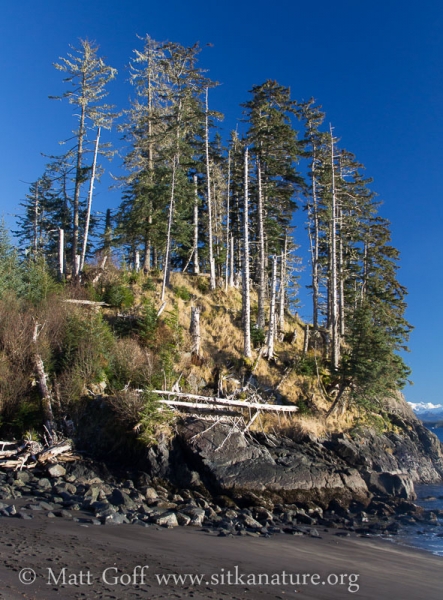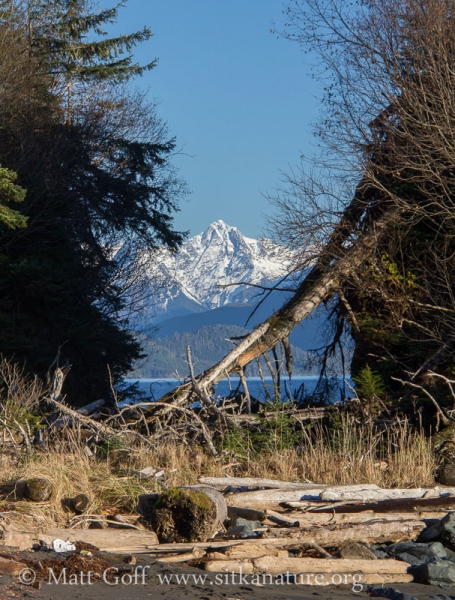A prominent feature at the north end of a long sandy beach, Yax̱latit Noow looks out over the northern lobe of Sitka Sound
Over the past few years one of my side projects has been to try and learn to speak/understand Tlingit. There is an active group of enthusiastic learners and teachers of the language in the region, which I am gratified to be a part of. I am sure everyone has their own motivations for engaging in this effort, and for me it is an outgrowth of my interest in natural history. One especially interesting (to me) resource that has been published is Haa Léelk’w Hás Aanà Saax’ú: Our Grandparents’ Names on the Land, an atlas of native place names around Southeast Alaska. The Sitka area has an especially rich collection, which, as I understand it, is due in part to some early (for this project) work to document place names with Charlie Joseph in the early 1980s.
Yax̱latit Noow is at the location called Kamenoi Point on current charts (though strictly speaking I’m not sure they are entirely equivalent – depending on the fuzziness of how feature names are applied). In Tlingit, as I understand it, Noow refers to a fortified place. This can apply both to constructed forts as well as rocky hills along a shoreline that presumably would have provided advantages in defending against attack. An example of the former type would be Shisk’i Noow, the fort at what is now Sitka National Historical Park. It was built to defend against the Russians after the Russian outpost at Old Sitka was destroyed. A more well recognized local example of the latter would be Noow Tlein, more widely known as Castle Hill. Although you wouldn’t know it now, it was formerly a tidewater island.
I do not know if every feature named as a noow actually was the sight of some sort of fort or defended location, nor do I know if Yax̱latit Noow in particular may have been associated with a settlement of some sort. I do suspect that in centuries past, it probably had less attachment with the main part of Kruzof Island. In the picture below you can see young spruce trees growing up in the gap between the hill and the forests of the main island. Relative sea level has been dropping for some time (due mainly to tectonic uplift and isostatic rebound), and it seems likely that within my lifetime or not long before, Yax̱latit Noow was regularly completely surrounded by water at high tides.
As for the name, Yax̱latit Noow is translated as Drifting ashore fort in the book. It’s easy to imagine this might associated with a story (as many names are), but I don’t know whether it is or not.
If anyone knows more about this or other names in this area, I would be grateful to learn more.
Gap between Yax̱latit Noow and main part of Kruzof Island. As the Young Spruce trees grow, this gap is likely to disappear


1 thought on “Yax̱latit Noow”